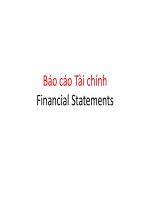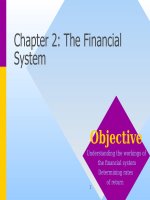Introduc corporate finance ch9
Bạn đang xem bản rút gọn của tài liệu. Xem và tải ngay bản đầy đủ của tài liệu tại đây (1.4 MB, 31 trang )
Chapter 9 Outline
9.1 Returns
9.2 Holding-Period Returns
9.3 Return Statistics
9.4 Average Stock Returns and Risk-Free
Returns
9.5 Risk Statistics
9.6 Summary and Conclusions
9.1Returns
Dollar Returns
Time
Dividends
the sum of the cash received
and the change in value of
the asset, in dollars.
0
Initial
investment
Ending
market value
1
•Percentage Returns
–the sum of the cash received and the
change in value of the asset divided by
the original investment.
Example -Calculating
Returns
Suppose you bought 100 shares of
Walmart (WMT) one year ago today at
$25. Over the last year, you received
$20 in dividends (= 20 cents per share
× 100 shares). At the end of the year,
the stock sells for $30. How did you do?
You invested $25 × 100 = $2,500. At
the end of the year, you have stock
worth $3,000 and cash dividends of
$20.
Example – Calculating
Returns
What is your dollar return?
Dollar return = $20 + (3000 – 2500) =
$520
What is your percentage return?
Dividend yield = 20 / 2500 = 0.8%
Capital gains yield = (3000 – 2500) /
2500 = 20%
Total percentage return = 0.8 + 20.0 =
20.8%
Returns: Example
Dollar Returns
$20
$520 gain
$3,000
Time
0
-$2,500
1
•Percentage Returns
20.8% =
$520
$2,500
9.2Holding-Period Returns
The holding period return is the return
that an investor would get when holding
an investment over a period of n years,
when the return during year i is given as
ri:
holding period return =
= (1 + r1 ) × (1 + r2 ) × × (1 + rn ) − 1
Holding Period Return:
Example
Suppose your investment provides the
following returns over a four-year
period:
Year Return
1
10%
2
-5%
3
20%
4
15%
Your holding period return =
= (1 + r1 ) × (1 + r2 ) × (1 + r3 ) × (1 + r4 ) − 1
= (1.10) × (.95) × (1.20) × (1.15) − 1
= .4421 = 44.21%
Holding Period Return:
Example
An investor who held this investment would have
actually realized an annual return of 9.58%:
Year Return
1
10%
2
-5%
3
20%
4
15%
Geometric average return =
(1 + rg ) 4 = (1 + r1 ) × (1 + r2 ) × (1 + r3 ) × (1 + r4 )
rg = 4 (1.10) × (.95) × (1.20) × (1.15) − 1
= .095844 = 9.58%
• So, our investor made 9.58% on his money for four years,
realizing a holding period return of 44.21%
1.4421 = (1.095844) 4
Holding Period Return:
Example
Note that the geometric average is not the same
thing as the arithmetic average:
Year Return
1
10%
2
-5%
3
20%
4
15%
r1 + r2 + r3 + r4
Arithmetic average return =
4
10% − 5% + 20% + 15%
=
= 10%
4
Risk, Return and Financial
Markets
We can examine returns in the financial
markets to help us determine the
appropriate returns on non-financial
assets
Lesson from capital market history
There is a reward for bearing risk
The greater the potential reward, the greater the risk
This is called the risk-return trade-of
Holding Period Returns
A famous set of studies dealing with the rates of
returns on common stocks, bonds, and Treasury bills
was conducted by Roger Ibbotson and Rex
Sinquefield.
They present year-by-year historical rates of return
starting in 1926 for the following five important
types of financial instruments in the United States:
Large-Company Common Stocks
Small-company Common Stocks
Long-Term Corporate Bonds
Long-Term U.S. Government Bonds
U.S. Treasury Bills
The Future Value of an
Investment of $1 in 1926
Return Statistics
The history of capital market returns
can be summarized by describing the
average return
( R1 + + RT )
R=
T
the standard deviation of those returns
2
2
2
(
R
−
R
)
+
(
R
−
R
)
+
(
R
−
R
)
1
2
T
SD = the
VAR
=
frequency
distribution of the returns.
T −1
Example
Year
Actual
Return
Averag
e
Return
Deviation from
the Mean
Squared
Deviation
1
.15
.105
.045
.002025
2
.09
.105
-.015
.000225
3
.06
.105
-.045
.002025
4
.12
.105
.015
.000225
Totals
.42
.00
.0045
Variance = .0045 / (4-1) = .0015
Standard Deviation = .03873
Historical Returns, 19262002
Series
Average
Annual Return
Standard
Deviation
Large Company Stocks
12.2%
20.5%
Small Company Stocks
16.9
33.2
Long-Term Corporate Bonds
6.2
8.7
Long-Term Government Bonds
5.8
9.4
U.S. Treasury Bills
3.8
3.2
Inflation
3.1
4.4
– 90%
Distribution
0%
+ 90%
Source: © Stocks, Bonds, Bills, and Inflation 2003 Yearbook™, Ibbotson Associates, Inc., Chicago (annually updates work by
Roger G. Ibbotson and Rex A. Sinquefield). All rights reserved.
Average Stock Returns and
Risk-Free Returns
The Risk Premium is the additional return (over
and above the risk-free rate) resulting from bearing
risk.
One of the most significant observations of stock
market data is this long-run excess of stock return
over the risk-free return.
The average excess return from large company common
stocks for the period 1926 through 1999 was 9.2% =
13.0% – 3.8%
The average excess return from small company common
stocks for the period 1926 through 1999 was 13.9% =
17.7% – 3.8%
The average excess return from long-term corporate bonds
for the period 1926 through 1999 was 2.3% = 6.1% – 3.8%
Risk Premia
Suppose that The Wall Street Journal announced
that the current rate for on-year Treasury bills is
5%.
What is the expected return on the market of
small-company stocks?
Recall that the average excess return from small
company common stocks for the period 1926
through 1999 was 13.9%
Given a risk-free rate of 5%, we have an expected
return on the market of small-company stocks of
18.9% = 13.9% + 5%
The Risk-Return Tradeof
18%
Small-Company Stocks
Annual Return Average
16%
14%
Large-Company Stocks
12%
10%
8%
6%
T-Bonds
4%
T-Bills
2%
0%
5%
10%
15%
20%
25%
Annual Return Standard Deviation
30%
35%
Rates of Return 1926-2002
Source: © Stocks, Bonds, Bills, and Inflation 2000 Yearbook™, Ibbotson Associates, Inc., Chicago (annually updates work by
Roger G. Ibbotson and Rex A. Sinquefield). All rights reserved.
Risk Premiums
Rate of return on T-bills is essentially riskfree.
Investing in stocks is risky, but there are
compensations.
The diference between the return on Tbills and stocks is the risk premium for
investing in stocks.
An old saying on Wall Street is “You can
either sleep well or eat well.”
Stock Market Volatility
Source: © Stocks, Bonds, Bills, and Inflation 2000 Yearbook™, Ibbotson Associates, Inc., Chicago (annually updates work by
Roger G. Ibbotson and Rex A. Sinquefield). All rights reserved.
Work the Web Example
How volatile are mutual funds?
Morningstar provides information on
mutual funds, including volatility
Click on the web surfer to go to the
Morningstar site
Pick a fund, such as the Aim European Development
fund (AEDCX)
Enter the ticker, press go and then scroll down to
volatility
Risk Statistics
There is no universally agreed-upon
definition of risk.
The measures of risk that we discuss are
variance and standard deviation.
The standard deviation is the standard
statistical measure of the spread of a sample,
and it will be the measure we use most of this
time.
Its interpretation is facilitated by a discussion
of the normal distribution.
Normal Distribution
A large enough sample drawn from a normal distribution
looks like a bell-shaped curve.
Probability
68%
95%
> 99%
–3
– 47.9%
–2
– 27.6%
–1
– 7.3%
0
13.0%
+1
33.3%
+2
53.6%
+3
73.9%
Return on
large company
common
stocks
•the probability that a yearly return will fall within 20.1 percent of the
mean of 13.3 percent will be approximately 2/3.
Normal Distribution
The 20.1-percent standard deviation we
found for stock returns from 1926
through 1999 can now be interpreted in
the following way: if stock returns are
approximately normally distributed, the
probability that a yearly return will fall
within 20.1 percent of the mean of 13.3
percent will be approximately 2/3.









